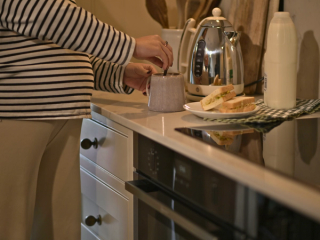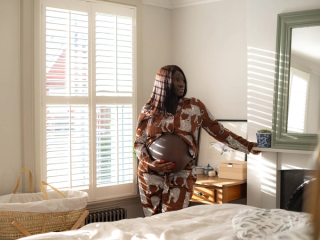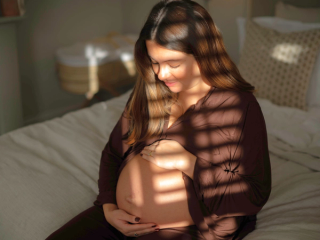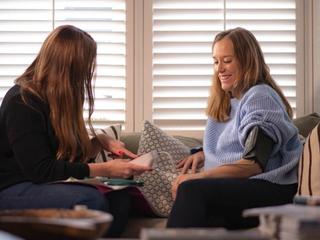
- Home
- Advice Hub
- Pregnancy
- Pregnancy Symptoms & Issues
- Pregnancy Ultrasound Scans
What your pregnancy scans will tell you
Learn about antenatal ultrasound scans, their purpose, and what to expect during pregnancy. Get essential insights for you and your baby's health.
How do ultrasounds scans work?
What are ultrasound scans used for?
How long do the ultrasounds scans take?
When are the scans offered?
Can I have more than two scans during my pregnancy?
What happens if the scan shows my baby is most likely to have a condition?
Are there any disadvantages to having a scan?
Having the first ultrasound scan during pregnancy is often an extremely exciting time for expectant parents. For some however, especially those who have had miscarriages, it can also bring about feelings of worry.
Ultrasound scans are imaging tests that are offered to all pregnant women in the UK. They are routinely offered twice during pregnancy, one between 11-14 weeks, known as the nuchal scan, dating scan or ’12 week scan’, and one between 18-22 weeks, known as the anomaly or anatomy scan.
Ultrasound scans use sound waves to create an image of your baby in the womb. They are painless and non-invasive when performed at the gestations mentioned. Occasionally if an early pregnancy scan is indicated, a transvaginal probe may need to be used as the baby is very small, making it difficult for the abdominal ones to pick up the image. Trying to visualise a baby on an 8 week ultrasound might be quite tricky to do externally, whereas it would be much easier at 12 weeks as the baby grows rapidly. An earlier scan might be requested if there are any issues during the first trimester such as bleeding or abdominal pain.
How do ultrasounds scans work?
Ultrasound scans work by using high-frequency sound waves to create images of the inside of the body. During the scan, a small device called a transducer emits sound waves that bounce off tissues, organs, or, in the case of pregnancy, the developing baby. The transducer picks up the returning echoes, which are then processed by a computer to produce images on a monitor. These images help medical professionals examine structures within the body without the need for surgery or invasive procedures.
During the scan, a sonographer applies a special gel to the mother’s abdomen, which helps the sound waves travel more effectively. The transducer is then moved over the abdomen to capture images of the baby on a screen.
When attending an ultrasound appointment at an NHS hospital, many women choose to bring their partner or a family member for support. It's a special moment for both parents, as they may see their baby for the first time. Most NHS hospitals allow partners or one or two family members to attend the scan. It’s often recommended to check the specific hospital’s policy ahead of time, especially if the number of guests is restricted due to space or current health guidelines. Being present at the scan can be an emotional and bonding experience, allowing loved ones to share in the excitement and anticipation of the baby's arrival.
What are ultrasound scans used for?
In a pregnancy ultrasound, this technology is used to monitor the growth and development of the baby. The scan can show details such as the baby's heartbeat, movements, and position. It can also reveal if there are multiple babies, estimate the due date, and check for certain developmental conditions.
How long do the ultrasounds scans take?
The first scan takes around 15 minutes and the second scan takes longer, usually around 30 minutes due to all of the baby’s structures that are being examined. It can be longer or shorter depending on how clearly the baby can be seen.
When are the scans offered?
The most common pregnancy ultrasound is the dating scan, usually performed around 12 weeks, and the anomaly scan, carried out between 18 and 22 weeks, to examine the baby’s anatomy in more detail.
11-14 week scan
The purpose of the 11-14 week scan is to confirm how many weeks and days pregnant you are and provide you with an estimated due date, and to ensure the baby is developing as the should be at that stage. The sonographer will also be confirming that your baby has a heartbeat, and checking to see whether you might be expecting more than one!
At the end of this scan, you will probably have a more accurate idea of when you will be expecting your baby, and you will have seen your baby for the very first time – though he or she won't look a whole lot like a baby just yet.
Nuchal translucency (NT) screening
At this stage, you will also have been offered a nuchal translucency (NT) test. This should have been discussed prior to your arrival for the scan but the sonographer will talk to you about it again, obtaining your consent before continuing.
A Nuchal translucency test (NT) is a way of estimating the risk of chromosomal abnormalities such as Down's Syndrome. It can be measured between 11 weeks and 13 weeks plus six days of pregnancy, by using ultrasound to measure the translucent (clear) space in the tissue at the back of your baby's neck. Babies with abnormalities tend to accumulate more fluid at the back of their neck during the first trimester, causing this fluid-filled space to be larger than average.
If you are having the NT screening test, the sonographer will do a dating scan first, to get an accurate estimate of how far along you are in your pregnancy. You will then have a blood sample taken. Your age and the information from the blood test and dating ultrasound are used to work out the chance of your baby having a chromosomal abnormality. A combined NT scan and blood test gives a more accurate diagnosis than an NT scan alone. This is available in most areas of the UK. The results come in the form of a risk factor, i.e. 1 in 10000, 1 in 1000 and so on. If the risk is thought to be high, you will be offered further diagnostic testing in the form of a more accurate blood test. The preliminary results usually come back quickly within a few days if high risk.
18-22 week anomaly scan
The anomaly or anatomy scan is a detailed ultrasound, usually carried out when you are between 18 weeks and 22 weeks pregnant. During this scan, the sonographer checks that the baby is growing normally, and looks at the position of the placenta. If your placenta is low in the uterus, you may need to have another scan late in your pregnancy to see whether it has moved; if it hasn't, you might be advised to have a caesarean section for safety the safety of yourself and your baby.
The other purpose of this scan is to detect potential physical abnormalities in your baby. As detailed as these scans are, they can't always pick up every abnormality. The anomaly scan is carried out in the same way as the dating scan. Most hospitals welcome partners into the room, and if your baby is in a cooperative mood and lying in the right position, you might well get some great images of that little face.
When will I find out the gender of my baby?
If you're keen to know the sex of your baby, ask the sonographer at the beginning of the 18-22 week scan. Depending on your baby's position in the womb, they might be able to tell you! If you’re keen to find out sooner, you may be able to pay privately for a scan from around 16 weeks. The sex of the baby is much easier to detect when they are closer to 20 weeks however.
Can I have more than two scans during my pregnancy?
The NHS routinely only offer two scans during pregnancy but more may be offered if they suspect a problem or if you are at a higher risk for developing an issue during pregnancy. This might be the case for twin and higher multiple pregnancy, those who have a high BMI, and babies whose growth has suspected to have slowed down. You might also be offered an early scan if a miscarriage has been suspected or if there are any known issues with the uterus or cervix.
What happens if the scan shows my baby is most likely to have a condition?
If it’s suspected that there is a problem with the baby’s development, further scans or diagnostic testing might be recommended. If a chromosomal abnormality is suspected, further blood tests, or amniotic fluid sampling may be offered. You’ll be referred to a consultant who will discuss your options and plan of care with you.
Are there any disadvantages to having a scan?
Ultrasound scans are painless and have no known physical effects on mum or baby - but in some cases, having a scan might create unnecessary worry for you and your partner. It might show a very minor problem, or something that may get better on its own.
As with all screening tests, scans aren't infallible: some scans yield false positive or false negative results. For example, about one in 20 women will appear to have babies at high risk of Down's syndrome. However, most of these babies turn out not to have Down's syndrome.
In the end, it's entirely up to you to decide if you want to have a scan. Your midwife, GP and obstetrician are all good people to talk to about any questions or concerns you might have.







